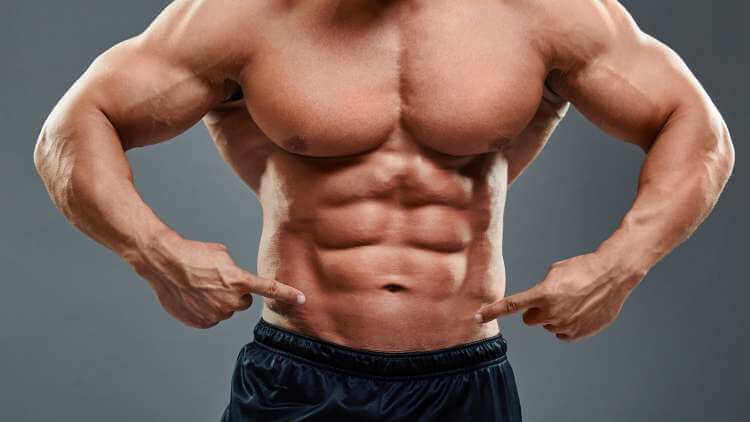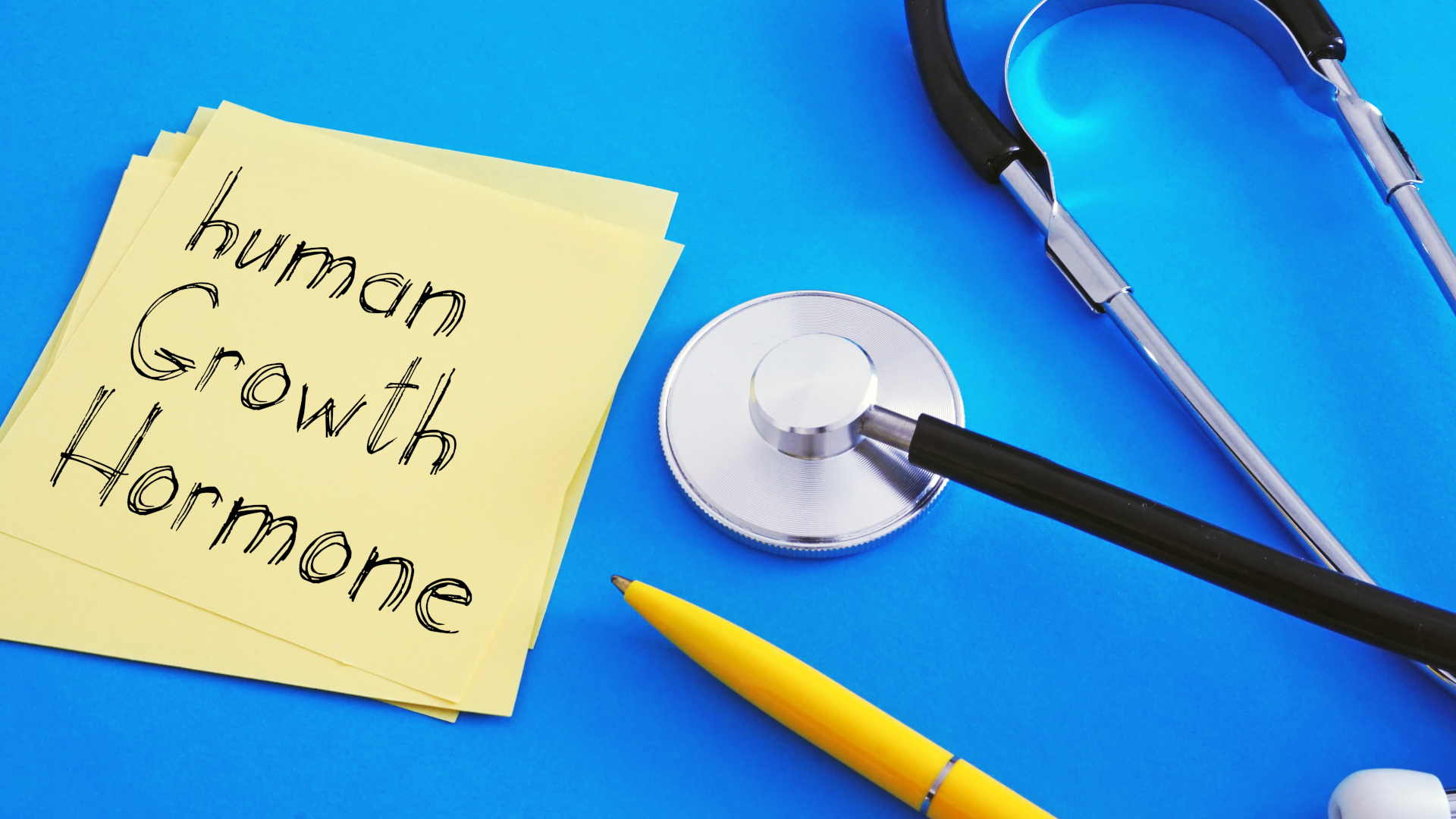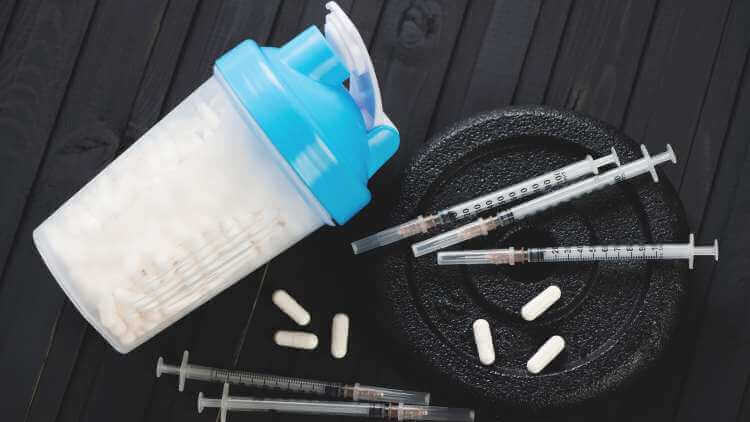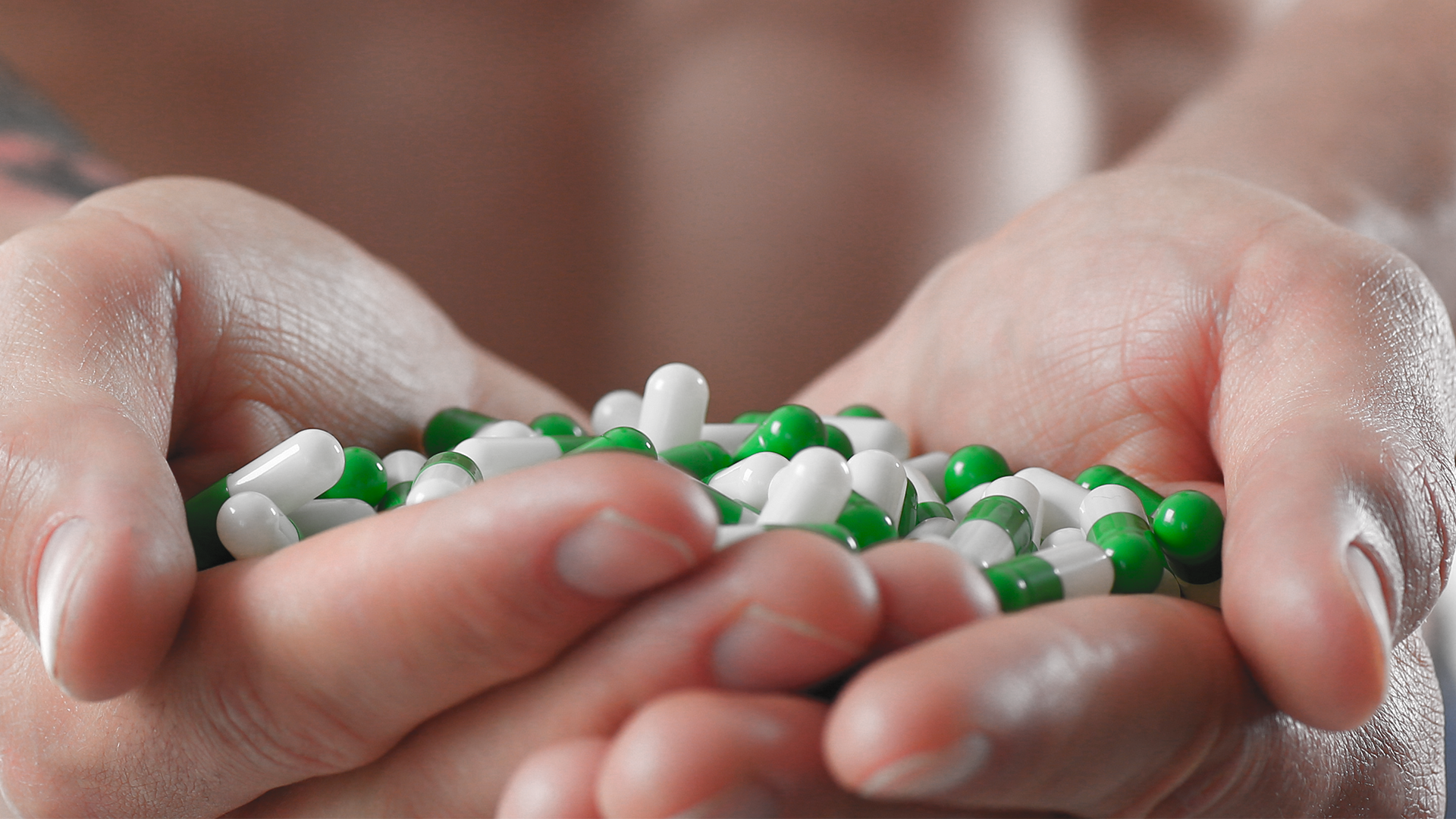- What is a ‘roid gut’?
- Why do some bodybuilders develop steroid guts?
- What substances can accelerate roid gut development?
- Tips for a healthy and natural bodybuilding
- Safe options that can help build muscle without side effects
What is a ‘roid gut’?
If you follow bodybuilding competitively, then you’ve probably already seen them. Chiselled, hulking bodybuilders who despite being covered in lean, rippling muscles, also look like they are about to pop out a baby. And we aren’t talking about the ladies here. We’re talking about the men.
It’s real, they exist and it is very strange to see, if you haven’t seen it already.
But where have these guts come from? They definitely didn’t exist back in the days of Arnold Schwarzenegger. Hell, every inch of them looked lean and tapered down to the perfect ‘v’ shape.
Yet this is no longer the case. Instead, what you see now is an oddly fascinating combo of enviable arms and distended stomachs.
So what is the cause? Why are more and more bodybuilders sporting ‘roid guts’?
Why do some bodybuilders develop steroid guts?
Now here is where things get even trickier. Not because there isn’t a reason. But because there are multiple explanations floating around about why it exists.

Palumboism: Understanding Bodybuilding Bubble Gut
Palumboism, also known as bodybuilding bubble gut, is a condition where the oblique muscles of the abdomen thicken and distend, making it challenging for bodybuilders to hold in their stomachs. Named after legendary bodybuilder Dave Palumbo, this phenomenon has several other names, including:
- Roid Gut
- Bodybuilding Bubble Gut
- Steroid Bubble Gut
- Insulin Gut
- HGH Gut
- Muscle Gut
This condition has sparked considerable debate in the bodybuilding community regarding its causes. The prevailing theory among judges is linked to the visceral growth that occurs during bulking. According to this theory, steroids are not solely responsible for the appearance of these distended stomachs, although they may contribute. Instead, performance-enhancing drugs such as insulin, recombinant human growth hormone, and occasionally other anabolic peptide hormones are implicated.
These substances can trigger:
- Visceral fat storage
- Increased connective tissue
- Swollen livers
- Ascites fluid
- Thickening musculature of the pelvis
These factors can leave the stomach looking bloated and distended.
On the surface, the science appears sound. For instance, insulin is associated with visceral and organ fat storage, so increasing it could theoretically expand the gut. However, considering the rigorous diets and fat-burning regimens bodybuilders follow, it is difficult to believe they would still have significant fat deposits in their livers and around their intestines.
Similarly, human growth hormones could potentially induce gut hypertrophy, causing organs to grow. Interestingly, testosterone can also trigger this "roid gut," yet it is not as criticized as insulin and GH.
Here's the real kicker—and why this debate remains so contentious: Despite more intense drug regimens and the increased size of bodybuilders, the pharmacological impact of insulin and GH on the gut hasn't changed. Thus, the sudden prominence of large stomachs in recent years doesn't entirely align with this theory.
By understanding both the definition and the ongoing discussions around Palumboism, we gain a clearer picture of this intriguing and controversial aspect of bodybuilding.
1. What are the alternative names for Palumboism?
It is also known by several other names, including "Roid Gut," "Bodybuilding Bubble Gut," "Steroid Bubble Gut," "Insulin Gut," "HGH Gut," and "Muscle Gut."
2. Who is Palumboism named after?
The condition is named after Dave Palumbo, a well-known figure in the bodybuilding world.
3. What is Palumboism?
Palumboism is a condition characterized by the thickening and distention of the oblique muscles in the abdomen, which makes it challenging for bodybuilders to maintain a flat stomach.
Take the following facts:
- There are no published studies/written evidence that indicates that GH or insulin causes abdominal distention. All the evidence is empirical.
- Bodybuilders only take 10-12 units of insulin before and after they train. Even if they took double, this is still less than what diabetics use. Do they have distended stomachs? No (mind they aren’t strenuously training in the gym either).
- In cases of patients taking GH to prevent muscle wastage, they take approx. 9-18 IU a day. Bodybuilders take 4-12 IU a day tops – nowhere near as much.
- Doctors never tell patients taking prescribed GH or insulin that they’ll experience radical abdominal distention from use. Even bodybuilding websites don’t post this warning.
- The only people who accuse GH and insulin of causing roid gut are internet experts commenting on contests (post event).
Add all of these together and what these facts suggest is that pharmacological use of GH and insulin – which is taken at much higher levels than bodybuilders – doesn’t cause abdominal distention.
So what is the real cause, if it isn’t entirely down to Palumboism? How are bodybuilders managing to be lean AND have fat stomachs when they have spent months rigorously training with the purpose of looking slim and powerful?
Here are some additional theories:
- Slow digestion – this can affect bodybuilders when they use diuretics and then carb-load (to saturate their muscles with glycogen), as they are usually dehydrated. This can create problems, as there is not enough water to make the glycogen they desire. As a result, their abdominal muscles become stretched (as they are so full) and fluid (blood) is drawn to it, leaving them with a big bulge trying to fill this vacuum.
- You can’t have a small waist with massive abs – it’s a simple fact. Even Arnie isn’t as massive as some of the bodybuilders you see these days.
- Not managing your medicine cabinet – it can be hard getting the balance right between diet, drugs and exercise when getting contest ready. Obviously you want to achieve maximum bulk before you cut; however, make a mistake in this chain and you won’t achieve the definition you want. It is regularly agreed upon that roid guts are a sign of something that went wrong during training – namely, with the drugs/supplements they’ve used. Use them right and you’ll experience minimum side effects. Get it wrong, and you could turn up competition day looking 4 months pregnant.
So is insulin and GH not to blame?
Yes and no.
Whilst there is no denying that there is no pharmacological proof of them being the cause of roid gut, they aren’t entirely innocent either. Can they encourage muscle growth? Yes. Can they enlarge your organs? To an extent.
But the same can be said of actual steroids, androgens, anti-cortisol drugs, some diets and training supplements. All of these can contribute to muscle growth.
And your stomach? Well, this is covered in muscle too and will grow alongside the rest (depending on how it is trained). The more you bulk… the more abdominal muscle you’ll amass.
What substances can accelerate roid gut development?
We’ve talked about the two biggest contenders already, but in this section we’ll go into more detail so you can see what all the fuss about and discover why so many people are adamant that they are the culprits.
Insulin
Insulin may be best known for its relationship with diabetes, but the thing to remember about this hormone is that our bodies tell us to produce it when we eat. With its help, we are better able to absorb sugar and nutrients into our bloodstream.
Now for bodybuilders, insulin is loved because of its high anabolic effects. It can help you to absorb more sugar from your blood and more protein. Combined this encourages increased protein synthesis and energy for muscle building, making it ideal for bulking.
The problem with insulin though, is that it can trigger heavy water retention. Now this wouldn’t be so bad if you weren’t also sporting a massive colon. Together, you can end up looking like you’ve swallowed a cantaloupe – ouch!
Human Growth Hormone
This bad boy usually plays a bigger role in our bodies when we are young as it helps us to grow. As we get older, our growth plates close over, stopping us from getting any bigger.
But this doesn’t mean it becomes inactive…
Alongside helping to stimulate the healing of wounds and damaged cells, it can also encourage muscle growth after they’ve been damaged. And here is where bodybuilding comes in, as weight training does exactly that – it damages your muscle fibers.
Similarly, HGH can help increase anabolic processes in your body, enabling muscle to rebuild whilst you sleep.
Sounds great right? Well, the problem with HGH is that it’s indiscriminate. This means it won’t just increase the size of your muscles. It will also increase the size of anything that doesn’t have a closed growth plate – including your hands, feet, face and organs (hence the problem with hypertrophy).
All growth in your abdomen will cause your stomach to get bigger, and your skin/muscle walls to grow larger in order to accommodate this increased size. And hey presto – you’ve got a noticeable gut despite having little fat on your body. Nice – umm no it isn’t.
Anabolic steroids
When we talked earlier about what causes steroid gut, you might remember us saying that despite the name, steroids actually have very little to do with roid gut. Well, it’s true! They are not one of the triggers.
This doesn’t mean they are entirely innocent. Use them during your bulking or cutting cycle and they will bolster the effects insulin and HGH have on stomach growth. For this reason, you will need to be mindful of what you put into your body because even though steroids are not the cause, in this case they can make the situation worse.
Studies:
A Japanese study in 2013 observed muscle growth in two parts. The first part consisted of an observational study of freshman and senior football players, and the second part an intervention study.
The first compared the differences in body composition between the freshman and senior players. They noted that as a result of intense bulking protocols and resistance training, the seniors weighed 17kg more (on average) than the freshmen (11-12kgs of lean muscle and 5-6kgs of fat mass). They also noted that their hearts, liver and kidneys were significantly heavier and were in proportion to the increases in fat and muscle.
The second study tried to reproduce this change by taking freshmen players and putting them through controlled bulking and training protocols over the course of a year. They witnessed pretty much the same results (but on a smaller scale as it was only for 12 months) as the observational study.
What does this study prove?
The fact is – GH, insulin, even testosterone can all cause increases to organ weight and size!
And considering that none of the participants were taking drugs; this study shows that the huge guts we now see in bodybuilders aren’t actually caused by drugs, but simply by whole-body growth.
Is it dangerous?
We may naturally produce insulin and HGH, but in this scenario, it isn’t entirely safe:
- HGH can lead to cardiac hypertrophy i.e. enlargement of your heart, which can increase the risk of heart attacks/strokes/heart failure. It can also cause similar growth in your lungs, which can be dangerous considering your rib cage can’t grow to accommodate this increased size.
Beyond these immediate concerns, the long-term effects of human growth hormone use can extend even further:
-
Fluid Retention: This can result in ankle swelling and exacerbate conditions like hypertension, increasing the strain on your cardiovascular system.
-
Headaches and Diabetes: Persistent headaches can become a common issue, and there is a potential increased risk of developing diabetes due to disrupted insulin regulation.
-
Cardiomyopathy: The heart may struggle to function effectively due to changes in its structure and size, leading to more severe health crises.
-
Cancer Risks: There is a potential for increased risk of certain cancers, including colorectal, thyroid, breast, and prostate cancer. This adds a significant layer of concern, as these conditions can have serious, long-term implications for overall health.
These potential effects highlight the importance of understanding the risks associated with HGH use. It's crucial to weigh these risks against any potential benefits and consult healthcare professionals before considering such treatments.
1. Are there any neurological or general systemic effects like headaches associated with HGH use?
Headaches are noted as a possible side effect, suggesting some neurological or systemic reactions to HGH.
2. Is there an increased risk of developing cancer with HGH use?
There is a potential heightened risk for certain cancers, including those affecting the colon, thyroid, breast, and prostate.
3. Does HGH use pose a risk for developing diabetes?
Yes, prolonged use of HGH can increase the likelihood of developing diabetes.
4. What are the potential impacts of HGH on fluid balance and circulation?
HGH use can lead to fluid retention, which may cause swelling in areas such as the ankles and contribute to high blood pressure.
-
- Insulin – funnily enough, taking insulin can potentially lead to diabetes. Hell, overdose on this hormone (in the short term) and it could send you into glycaemic shock or even a coma.
Tips for a Healthy and Natural Bodybuilding
If you’re thinking about how to avoid Palumboism and a distended gut, the first step is to steer clear of using anabolic steroids, human growth hormone (HGH), and insulin. The misuse of these substances can lead to severe physical alterations, such as the infamous "roid gut." Instead, opt for a healthier, more natural approach to bodybuilding.
Here are some fitness and dietary recommendations to help you build muscle safely:
Exercise
Focus on a mix of compound and isolation exercises:
-
Compound exercises: These allow you to work out multiple muscle groups at once. Examples include squats, bench press, rows, shoulder press, and pull-ups. They should form the core of your workout program, featuring heavy weight lifts and low reps.
-
Isolation exercises: These target single muscle groups using lighter weights and higher reps. They are essential for muscle definition and balance.
To maximize your workout effectiveness, ensure you rest adequately between sets: about 120 seconds for compound exercises and 30-60 seconds for isolation exercises.
Sample Workout Program
Upper Body
- Bench press: 4 sets, 5 reps
- Rows: 4 sets, 5 reps
- Shoulder press: 3 sets, 6-8 reps
- Bicep curls: 2 sets, 10 reps
- Tricep extensions: 2 sets, 10 reps
- Lateral raises: 2 sets, 12 reps
Lower Body
- Squats: 5 sets, 3-5 reps
- Leg press: 3 sets, 6 reps
- Lunges: 2 sets, 8 reps
- Leg extension: 2 sets, 12 reps
- Hamstring curl: 2 sets, 12 reps
- Calf raises: 3 sets, 15 reps
- Hanging leg raises: 2 sets, 15 reps
Diet
Nutrition is the foundation of muscle building. Ensure your diet includes:
- Lean protein: 0.8-1.2 grams per pound of bodyweight, with 0.2-0.25 grams per pound immediately post-workout.
- Carbohydrates: At least 100 grams per day to fuel your training.
- Dietary fats: No fewer than 0.35 grams per pound per day.
- Calorie surplus: Consume 250-500 more calories than your daily allowance to support muscle growth.
Adopt clean eating habits by splitting your meals into 3-6 smaller portions per day and eating about 2 hours before exercising to maximize energy availability.
By focusing on these natural and informed strategies, you can achieve your bodybuilding goals while safeguarding against unwanted side effects like Palumboism and distended gut.
1. What are the potential consequences of misusing these substances?
Misusing HGH and insulin can lead to severe physical changes, such as the development of a "roid gut," which is a condition characterized by a distended abdomen.
2. What substances should be avoided to prevent Palumboism and a distended gut?
To prevent Palumboism and a distended gut, it's crucial to refrain from using anabolic steroids, human growth hormone (HGH), and insulin.
Safe options that can help build muscle without side effects
Is roid gut real? Very much so. Can it be avoided? Yes!
The truth is – you don’t have to suffer from excess abdominal muscle in order to achieve massive muscle mass gains. Hell, the above training regime and diet alone are proof that you don’t have to subject your body to this. So, while it might appear to be the trend for current bodybuilders to have a gut, YOU don’t have to follow suit.
In fact, there are a whole host of safer, natural and legal steroids alternatives that can help you to achieve the lean gains you crave, without you having to look pregnant at the same time.
Instead you can end your cycle looking lean, chiselled and huge like Arnie, with the very same perfect tapered ‘v’.
CrazyBulk supplies a range of 100% legal bodybuilding supplements that can be safely used to: increase lean muscle mass; cut fat; improve muscle recovery; maximize your physical endurance, stamina and strength, and more importantly, help you to successfully complete your bulking and cutting cycles.
PLUS, there isn’t a distended stomach in sight.
From Testo-Max and D-Bal (for bulking) to Anvarol and Win-Max (for cutting) – they can offer you a safer, more natural way to achieve the body you want, with none of the side effects of anabolic steroids. So why wait?
Conclusion
So does ‘roid gut’ have to be a part of your competing future? No, it doesn’t.
True, more studies need to be done about what causes steroid gut. However, everything we’ve seen so far points to the fact that as long as you get the right combo – and don’t rely on insulin, testosterone or HGH for muscle growth – you CAN achieve the same gains as all your favourite bodybuilders. Plus, you can do it WITHOUT having to deal with a steroid gut.
And let’s be honest – do you really want to walk around with a gut even if there isn’t an ounce of fat there? No! Unless you shout that fact from the rooftops, no one is going to understand that it is actually muscle. It isn’t pretty. It isn’t attractive and it isn’t a true representation of all your hard work.
So if you’re interested in experiencing real gains with none of the side effects and discomfort, why not take the natural route instead?
Train right, eat ‘clean’, and incorporate a proven, safe and legal steroid alternative into your cycle, and you CAN experience real muscle gains, fat loss AND definition. Yep, enough to rival all your favorite 80s/90s bodybuilding heroes.
Over 299,434 purchases
Over 509,389 bottles sold
Over 30,563,340 pills taken








